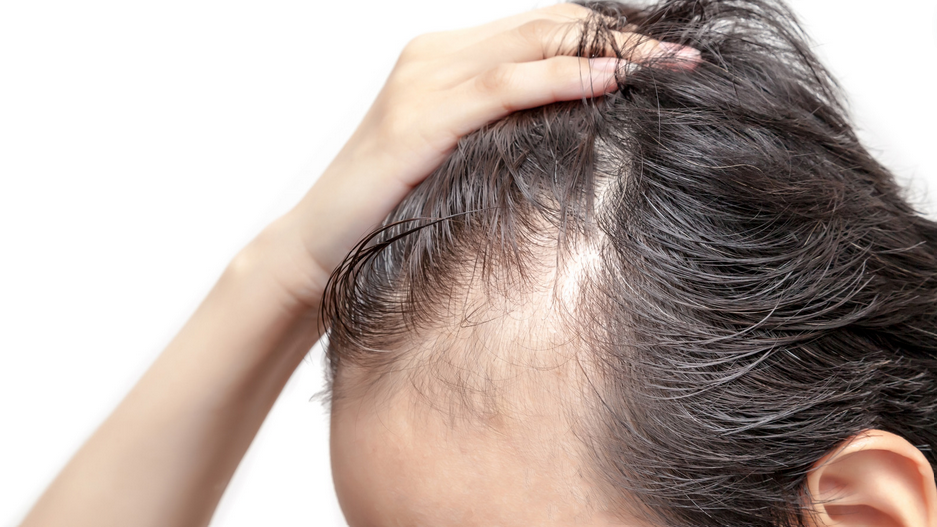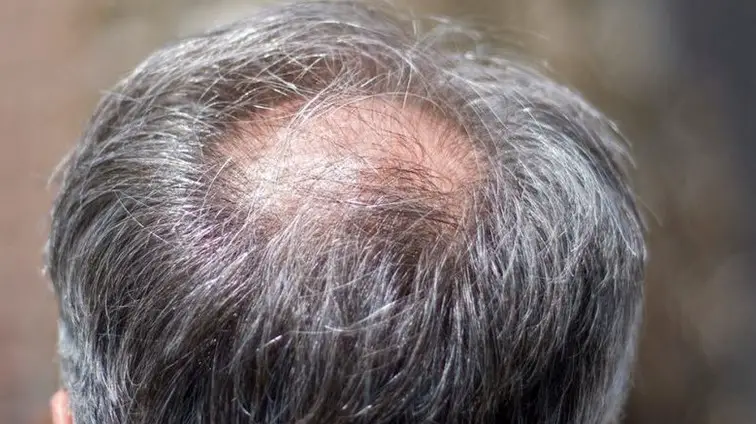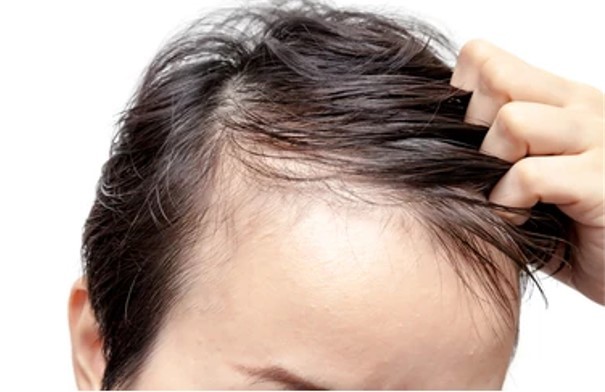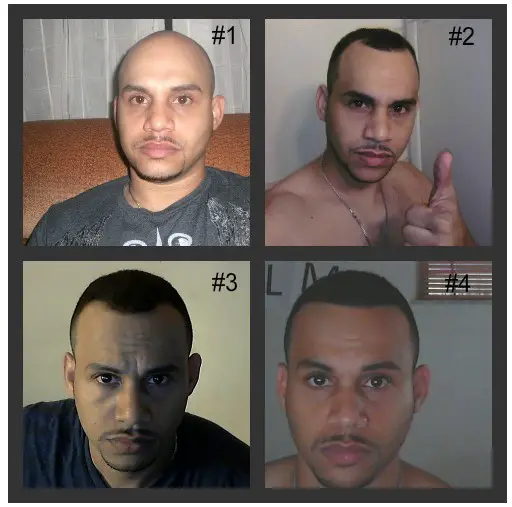Are you noticing changes in your hairline and wondering if it’s any first signs of receding hairline? You’re not alone, as many individuals face this common issue. In this blog post, we will explore the signs of a receding hairline, discuss potential causes, and provide tips on how to manage and treat it effectively.
Let’s dive into the world of hair health together so you can confidently understand what’s happening with your hair and take proactive steps for a fuller-looking mane. Keep reading to learn more about this widespread condition affecting both men and women!
Understanding Receding Hairline
Receding hairline is a common type of hair loss that typically begins with thinning at the temples and forehead and can slowly progress to the crown of the head.
Definition And Causes
A receding hairline occurs when the hair above the temples and forehead starts to thin out, gradually moving backwards and creating an “M” shape at the front of the scalp. This condition is most commonly associated with male pattern baldness, a genetically-inherited trait that affects many men as they age. However, women can also experience a receding hairline due to female pattern hair loss or other factors such as hormonal changes.
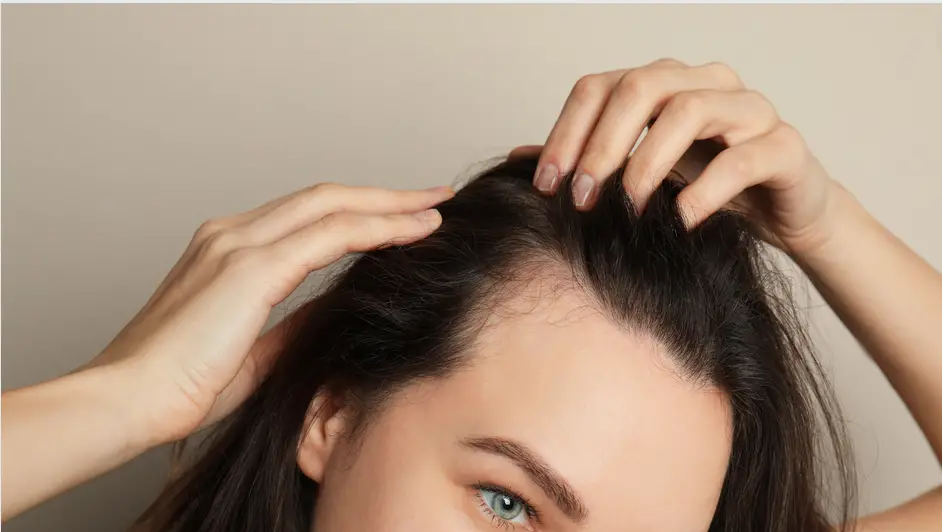
Various causes contribute to a receding hairline aside from genetics. Factors like hormonal imbalances, certain medications, high levels of stress, and poor nutrition can all play a role in accelerating this process. For example, individuals with thyroid disorders may notice their hair thinning more rapidly than those without such issues. Similarly, prolonged exposure to harsh chemicals found in some hairstyling products or treatments may damage your follicles over time and lead to premature recession of your natural hairline. Knowing these underlying causes can help you take preventive measures or seek appropriate treatment options for restoring your locks’ former glory.
Differences Between Receding Hairline And Balding
A receding hairline and balding are two distinct aspects of hair loss, though they can be closely related. A receding hairline refers to the gradual movement of the hairline further back on the head, leaving more forehead exposed. This is typically characterized by an M-shaped pattern at the temples or a general thinning around this area in both men and women. On the other hand, balding is a broader term encompassing various types of overall hair loss, including male pattern baldness – which affects mainly the top and front portions of the scalp – and female pattern hair loss, where thinning occurs diffusely across most areas.
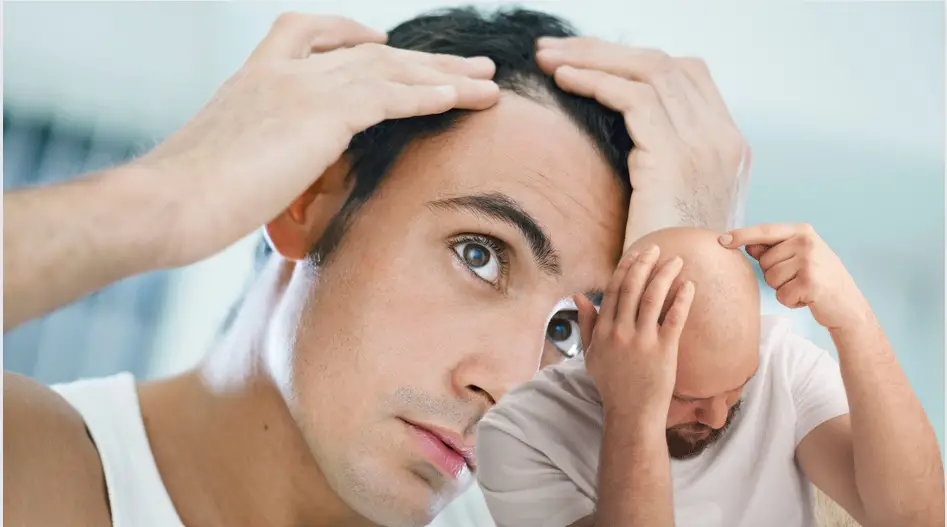
A receding hairline can be an early sign or precursor to further balding as it represents one type of male or female pattern hair loss progression; however, not everyone with a receding hairline will eventually become completely bald. It’s essential to recognize that even if you have signs of receding hairs like widening partings lines and miniaturization of follicles, you may still maintain some degree of coverage on your scalp without progressing into full-fledged baldness.
Genetics play a significant role in determining whether someone experiences either condition; those with family members who have dealt with similar issues are more likely to experience them as well. Moreover, certain hairstyles (such as tight ponytails), stress levels, medications or hormonal imbalances can also contribute to these conditions occurring independently from each other. Understanding these distinctions between a receding hairline and complete baldness is critical when considering potential treatment options for restoring lost locks.
Signs And Symptoms Of Receding Hairline
If you’re experiencing thinning hair at the temples and forehead, widening of the parting line, or changes in hair texture, then continue reading to learn more about the signs and symptoms of receding hairline.
?1. Thinning Hair At The Temples And Forehead
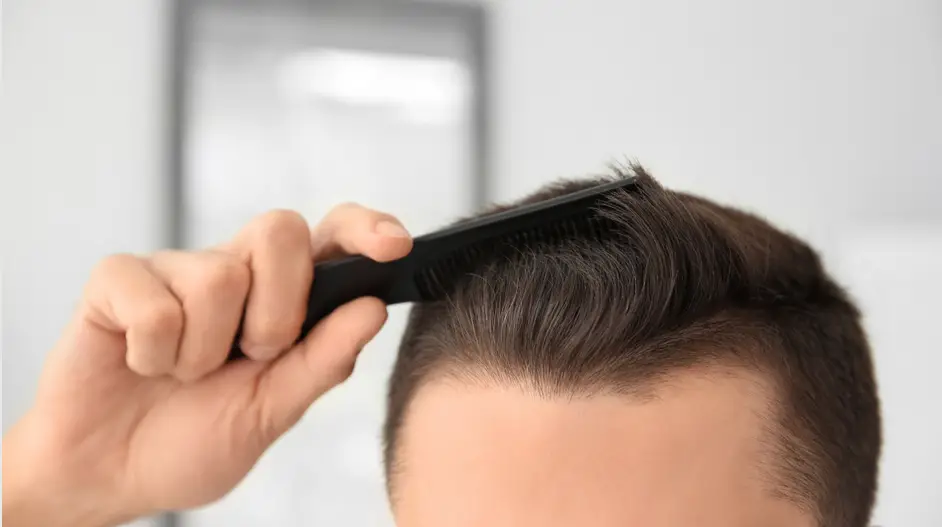
How to tell if you have thinning hair at the temples and forehead is often one of the first noticeable signs that a receding hairline may be developing. This pattern of hair loss occurs in both men and women and can be caused by various factors such as genetics, hormonal changes, or underlying health conditions. For example, male pattern baldness (androgenetic alopecia) affects approximately 50% of men by age 50, while female pattern hair loss impacts roughly 30-40% of postmenopausal women.
In addition to genetic predispositions to temple hair loss in female, thinning hair and receding hairlines, certain hairstyles for both men and women can contribute to this type of issue. Traction alopecia is a common cause among people who frequently wear tight ponytails, braids or cornrows that pull on the scalp. Recognizing early signs of thin natural hair like these can lead to proactive measures being taken – including changing hairstyles or using specialized treatments – which help prevent further progression of an unwanted receding hairline.
?2. Widening Of The Parting Line
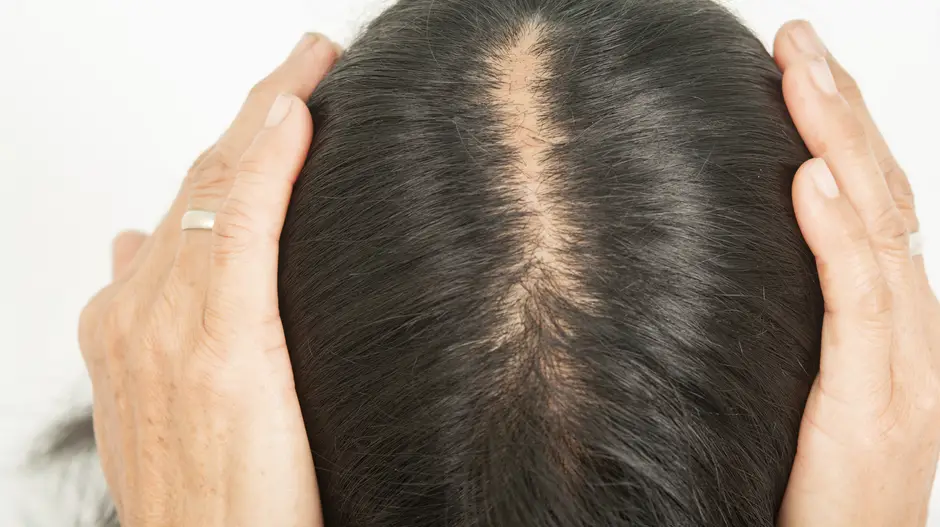
Another sign of a receding hairline is the widening of the parting line. This happens when the hair on either side of your part starts to become sparse, making your scalp more visible in that area. It can be a gradual process that takes place over time, and it’s not always immediately noticeable. However, if you start to notice an unusual amount of scalp showing through your hair or if you can’t style it as easily as before due to thinning strands, then it may be time to consult with a specialist.
This symptom affects both men and women and is often one of the early signs of balding. In women, a wider part line may occur suddenly during hormonal changes associated with pregnancy or menopause. For some people, genetics are also involved in how quickly their hair thins out around this area. Fortunately, there are ways to treat and prevent balding such as topical treatments like Minoxidil or dietary supplements like biotin, which have been shown to improve hair health by increasing volume and thickness in many cases.
?3. Miniaturization Of Hair Follicles
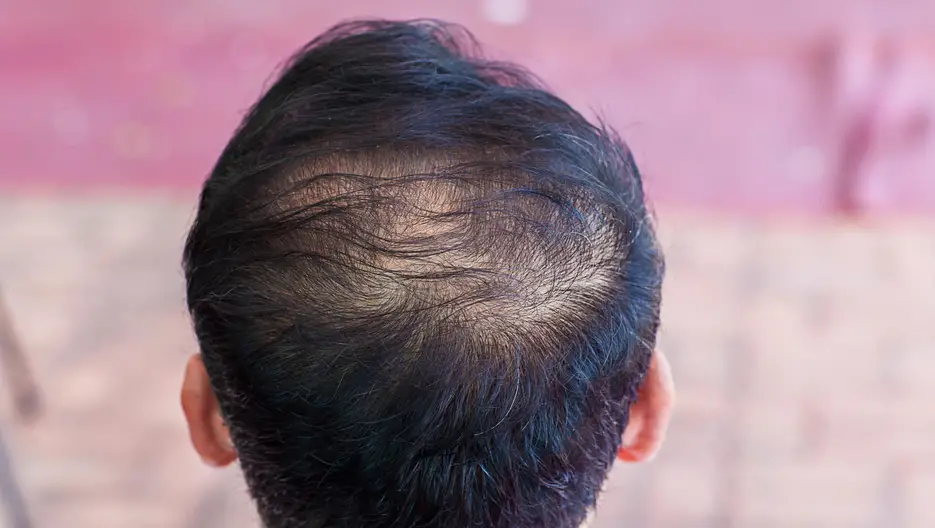
Miniaturization of hair follicles is one of the most common causes of signs and symptoms of receding hairline. This process occurs when hair follicles start producing thinner and shorter hairs, leading to a gradual thinning of the scalp. As miniaturization progresses, these hairs may eventually become transparent or invisible, giving an impression of baldness.
Male pattern alopecia is the most typical form associated with miniaturization, affecting both men and women. During this process, testosterone in males converts to dihydrotestosterone (DHT), which then attaches to the receptors on the hair follicles, causing them to shrink in size over time. DHT also shortens the growth phase and prolongs the resting phase causing fewer healthy hairs to be produced by affected follicles, ultimately resulting in a weakened scalp.
If left untreated for an extended period, miniaturization can lead to permanent damage resulting in hair loss that may not be reversible without medical intervention such as surgery or natural treatment options like supplements, laser therapy or scalp massages that help stimulate blood flow towards affected areas thus promoting new cell regeneration.
?4. Hairline That Resembles A Letter “M”
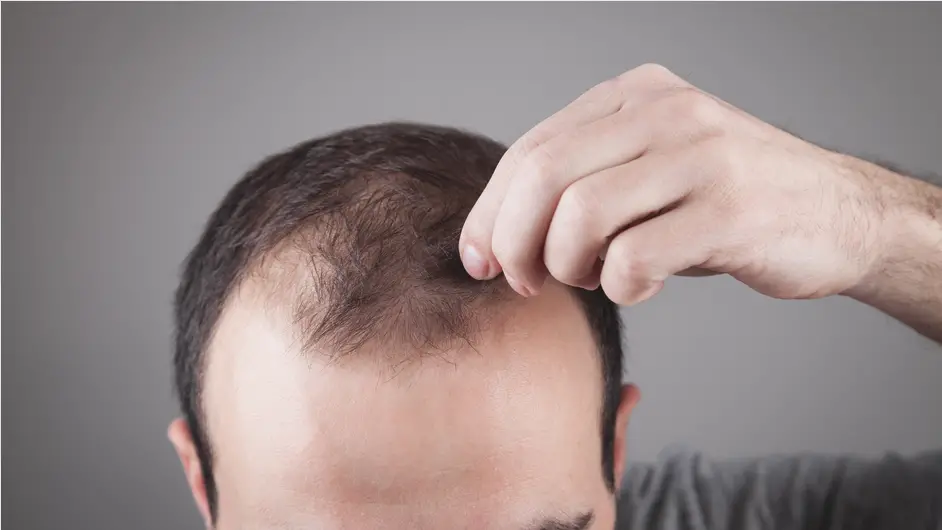
One of the most notable signs of a receding hairline is when it starts to resemble an “M” shape. This occurs due to the hairline receding from both corners of the forehead, resulting in a central point forming at the top. It’s important to note that not all individuals with an M-shaped hairline experience baldness, as this can occur naturally with age and is known as a mature hairline.
However, if you notice thinning or miniaturization of the hair follicles around your temples and forehead area along with an M-shaped hairline, it could be a sign of male-pattern baldness or female-pattern baldness. Hair loss caused by genetic factors tends to follow predictable patterns like this one but may still affect people differently. In some cases, consulting with a dermatologist or trichologist can help provide proper diagnosis and treatment options for those experiencing this type of hair loss pattern.
?5. Changes In Hair Texture
Changes in hair texture can be an early sign of receding hairline in both men and women. The affected area may feel thinner or coarser, with a different consistency compared to the surrounding healthy hair. Hair can also become more brittle, fragile, and prone to breakage. In some cases, dryness and scalp irritation accompany changes in texture.
Hair loss and alopecia are common causes of changes in hair texture associated with receding hairline signs. Alopecia is an autoimmune disorder that results in patches of baldness on the scalp or body; this condition can cause irregularities in skin pigmentation as well as unusual curling or straightening of affected hair strands. Other illnesses that lead to hormonal imbalances, such as thyroid disease or polycystic ovary syndrome (PCOS), can also affect the texture of hair, leading to thinning at the front for females.
?6. Uneven Hairline
An uneven hairline is a common sign of receding hairline in both men and women. This can be caused by various factors, including genetics, damage to the hair follicles, or male pattern baldness. An irregular hairline may make some parts of the scalp look patchy with less hair compared to others. Uneven hairlines may also appear asymmetrical and irregular.
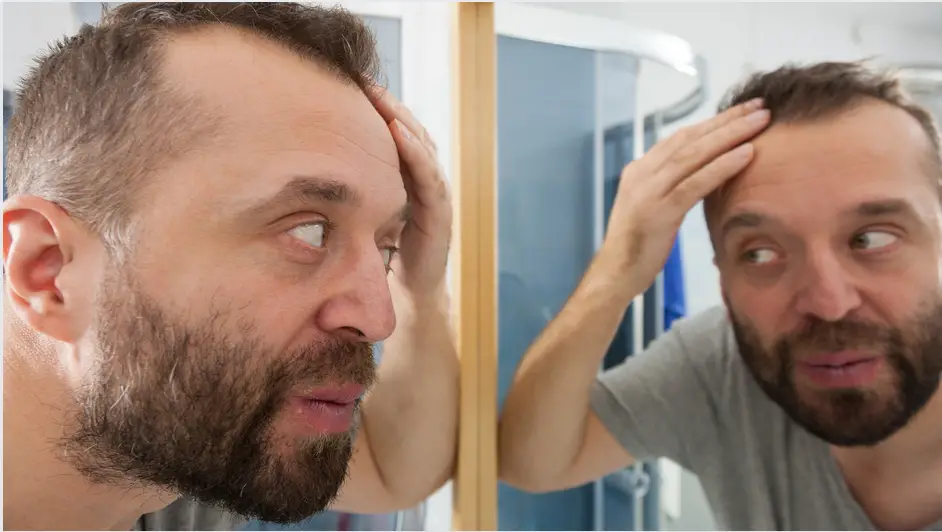
It’s important to note that an uneven hairline is a natural part of ageing for up to 25% of men who experience noticeable hair loss by the time they reach 21 years old. However, if you notice sudden changes or excessive shedding in your hair, it’s essential to consult with a specialist to determine the underlying cause and possible treatment options such as topical treatments like Minoxidil and Finasteride or lifestyle changes like stress reduction and a healthy diet. Additionally, styling techniques such as wearing hats, headbands, or textured cropped hairstyles can help boost confidence while managing an uneven hairline appearance.
?7. More Scalp Visible
Another common sign of a receding hairline is when more of the scalp becomes visible. This occurs as hair gradually thins and falls out at the front of the scalp, leaving larger areas of bare skin exposed. In men, this often starts with a widening or deepening of the parting line, while in women, it can appear as diffuse thinning throughout the entire top of the head.
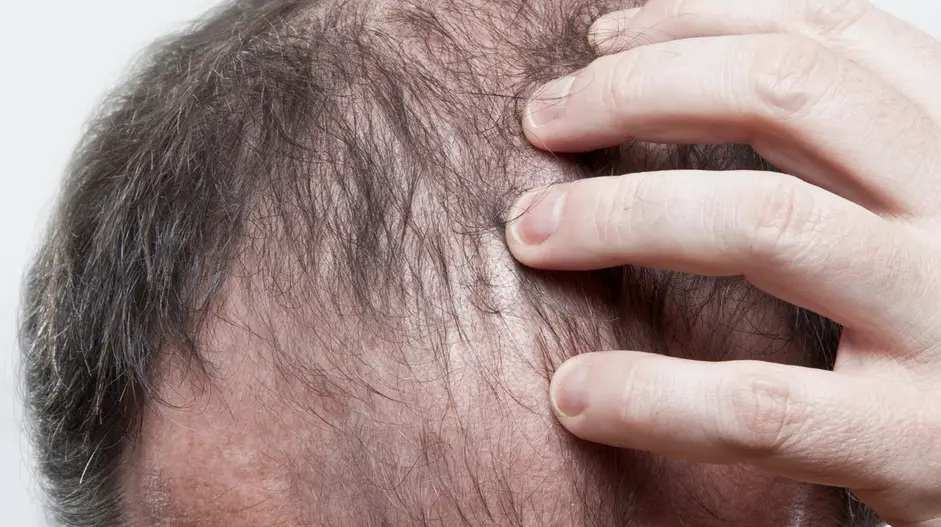
Having more scalp visible can be particularly distressing for those experiencing a receding hairline, especially if they are still young or in their prime years. It may also make them feel self-conscious about their appearance and lead to decreased confidence levels. However, there are various options available to help manage this condition and restore lost hair growth. Consulting with a specialist and exploring treatment options such as medications or transplants can often yield positive results for both men and women dealing with this issue. Here you can read more on why can I see my scalp through my hair.
?8. Crown Looking Thinner
Thinning hair on the crown is another symptom of a receding hairline that both men and women can experience. As you age, your hair follicles gradually shrink, which causes thinning and eventually balding. Male pattern baldness is usually characterized by a receding hairline at the temples with a progressively balding crown area. Women’s hair loss typically happens more uniformly across their scalp, resulting in general thinning all over their heads rather than localized patches.
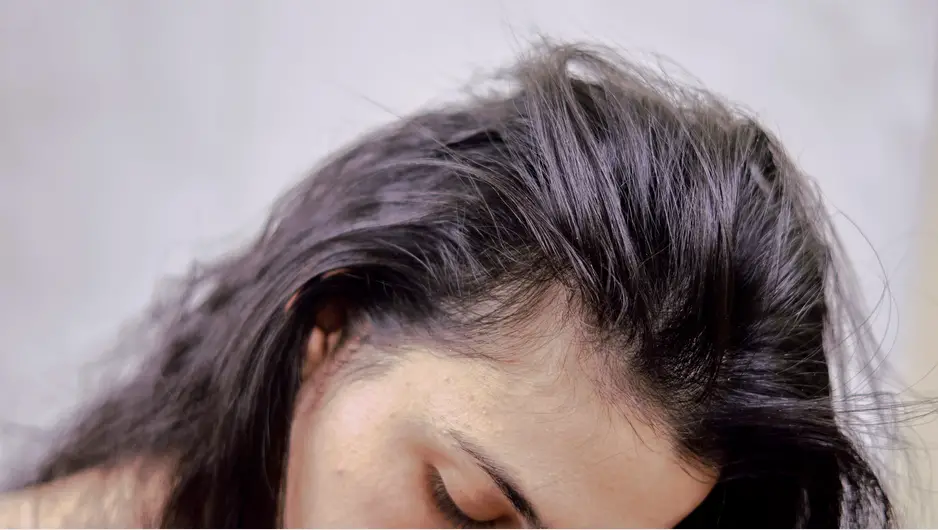
The signs of a thinning crown could include decreased density or an increase in the visible scalp, as well as hairs that are finer than usual or becoming easily breakable around the top of the head. This kind of gradual change might not be noticeable until it has progressed significantly enough to reveal larger patches where no new hairs are growing anymore. To prevent further damage and promote healthy growth from remaining follicles, use gentle products on your scalp (such as natural oils) and avoid chemical treatments like perms or bleaching agents that can cause additional stress to already-sensitive strands.
You will also like:
- Receding hairline at 20 – is it normal?
- Receding Hairline or a Big Forehead – Which one I have?
- Is Mature Hairline Balding – (Mature Hairline vs Receding)
- Balding Crown But No Receding Hairline
- Widows Peak vs Receding Hairline
- Receding Hairlines In Women
- Receding Hairline Stages
How To Tell If You Have A Receding Hairline
There are several ways to tell if you have a receding hairline, including consulting with a hair specialist, using a ruler or app to measure hairline recession, comparing old and new photos, and looking for signs of excessive hair shedding.
Consulting With A Hair Specialist
If you suspect that you have a receding hairline, it’s essential to consult with a hair specialist. A dermatologist or trichologist can examine your scalp and hair follicles carefully to diagnose the cause of your hair loss accurately. They will also review your medical history, including any medications or supplements you are taking, as some drugs may contribute to hair loss.
A professional assessment is crucial in determining if you have male pattern baldness or another form of alopecia. The sooner you visit a specialist, the better chance they have at creating an effective treatment plan for your specific condition. Remember that even though there is no cure for male-pattern baldness, available treatments can help slow down its progression and improve the appearance of affected areas.
Using A Ruler Or App To Measure Hairline Recession
Measuring hairline recession can be an essential tool for identifying a receding hairline. One popular method involves using a ruler or app to measure the distance between the eyebrow and the hairline. This method helps determine if there has been any significant change in the position of the hairline, which can indicate the early stages of male pattern baldness.
Another way to use a ruler is by placing it along your parting line on top of your head and checking how far back your hair goes from there. If it falls more than two inches behind that line, then you are likely experiencing a receding hairline. Some apps also help measure hair density in certain areas, providing insight into where there might be thinning or miniaturization of the follicles.
Measuring changes in your hairline with a ruler or app can give you an idea of whether you have just had normal changes due to ageing or have real concerns about male pattern baldness. While measuring doesn’t necessarily guarantee accurate results all the time, doing so regularly will provide valuable data that could help identify any potential problems early on before they become too severe to manage easily.
Comparing Old And New Photos
One of the most effective ways to determine if you have a receding hairline is by comparing old and new photos. This can help you identify any changes in your hairline over time and give you a better idea of how much it has receded. Look for any noticeable differences around the temples or forehead, as these areas are often the first to show signs of hair loss.
In addition to comparing photos, you can also use a ruler or app to measure your hairline recession. This can provide more accurate measurements and help track changes over time. Keep in mind that while some degree of hair loss is normal as we age, excessive hair shedding or sudden bald patches may require medical attention.
By being proactive about monitoring your hairline and seeking professional advice when necessary, you can take control of your appearance and find solutions that work for you.
Looking For Signs Of Excessive Hair Shedding
One of the signs of a receding hairline is excessive hair shedding. It’s normal to lose between 50 and 100 hairs each day, but if you’re finding more and more strands on your clothes or in the shower, it could be a sign of alopecia. You may find that your hair feels thinner all over, not just at the temples or crown.
To determine if you are experiencing excessive hair shedding due to a receding hairline, try gently pulling on a small section of your hair near the root. If more than three hairs come out with minimal effort or there are visible patches without any hair, this could indicate an issue.
Remember that genetics plays a major role in whether you develop male pattern baldness or female pattern baldness (androgenic alopecia), so talking to a dermatologist as soon as possible can help identify whether there are underlying medical conditions contributing to excessive shedding and recommend treatments accordingly.
Top 10 Hairstyles For A Receding Hairline
Discover the best hairstyles for receding hairlines, from the classic buzz cut to trendy textured crops. Don’t let a receding hairline hold you back from looking your best – check out our top 10 hairstyles and find one that suits your personal style!
Buzz Cut
A buzz cut is one of the most popular hairstyles for men with a receding hairline. It involves cutting the hair very short, usually to a length of around ⅛ inch, using clippers. The buzz cut not only looks clean and stylish but also minimizes the appearance of balding by reducing the contrast between hair and scalp. Men who are experiencing thinning hair or baldness due to androgenetic alopecia (male pattern baldness) may find that the buzz cut helps them feel more confident about their appearance.
Women can also opt for a pixie-style version of this haircut which involves leaving slightly longer strands on top while keeping extremely short sides and back. This style complements facial features making it perfect for women with varying face shapes as it draws attention away from an uneven hairline while giving any woman a bold look. The key advantage is that it requires no styling maintenance, so you can simply wash, condition, dry & go in seconds.
It’s important to note that although the buzz cut works well for some people, it might not suit everyone’s personal preferences or style choices. Also, getting too low or too frequent shaves with clippers could make your scalp vulnerable to sunburns because they tend to expose your skin more than normal-length hairs would make, so regular application of sunscreen on your head will be recommended.
Crew Cut
The crew cut is a classic short hairstyle that is low maintenance and easy to style, making it a great option for men and women with a receding hairline. Here are some benefits of the crew cut:
1. The crew cut is a versatile hairstyle that can be adapted to suit different head shapes and facial structures.
2. This hairstyle is ideal for those who want to keep their hair looking neat and tidy without spending too much time styling.
3. The crew cut allows for a bit of length on top while still being a short style, making it an excellent option for those with a receding hairline.
4. A well-executed crew cut with blended edges can create the illusion of thicker hair, masking the signs of hair loss.
5. The crew cut works well with different hair types and textures, from straight to curly and everything in between.
So if you’re looking for a low-maintenance hairstyle that will help disguise your receding hairline, give the crew cut a try!
Side Part Hairstyle
The side-part hairstyle is a classic and timeless option for men with a receding hairline. It involves creating a clean, diagonal part on one side of the head and combing the hair over to the other side. This style works well with different hair types, lengths, and face shapes.
To achieve this look, start by washing your hair with a gentle shampoo and conditioner that won’t harm or dry out your scalp. Then, use a comb to create a clear part on one side of your head. Using some styling product like pomade or wax will help you keep it in place throughout the day. Lastly, use your fingers to gently comb the rest of your hair over to one side.
Overall, the side part hairstyle helps draw attention away from thinning areas around the temples while emphasizing volume at the back of your head. It’s an excellent choice for anyone looking for a sophisticated yet easy-to-style haircut that can work both in formal settings and casual outings.
Slicked Back Hairstyle
A slicked-back hairstyle is a great option for both men and women with receding hairlines. Here are some reasons why:
1. It can take the emphasis away from thinning temples and a receding hairline.
2. It is versatile, as it can be achieved with different lengths of hair and product types.
3. It can give the appearance of thicker hair by smoothing any remaining hair over the balding areas.
4. It is easy to maintain and style, making it a convenient choice for those with busy lifestyles.
5. When paired with a well-groomed beard, it can create a stylish and put-together look that draws attention away from the hairline.
Keep in mind that while this hairstyle may be a great option for many people with receding hairlines, it may not work for everyone depending on the severity of their hair loss or individual preferences.
Comb Over Hairstyle
One of the top 10 hairstyles for a receding hairline is the comb-over hairstyle. This style works by using the receding hairline as the lowest point in the hair’s natural part line, allowing the hair to fall forward and cover up any bald patches. To achieve this look, start with clean, damp hair and use a fine-toothed comb to create a deep side part on one side of your head. Then, use some light-hold styling gel or mousse to slick your hair down and forward over your scalp.
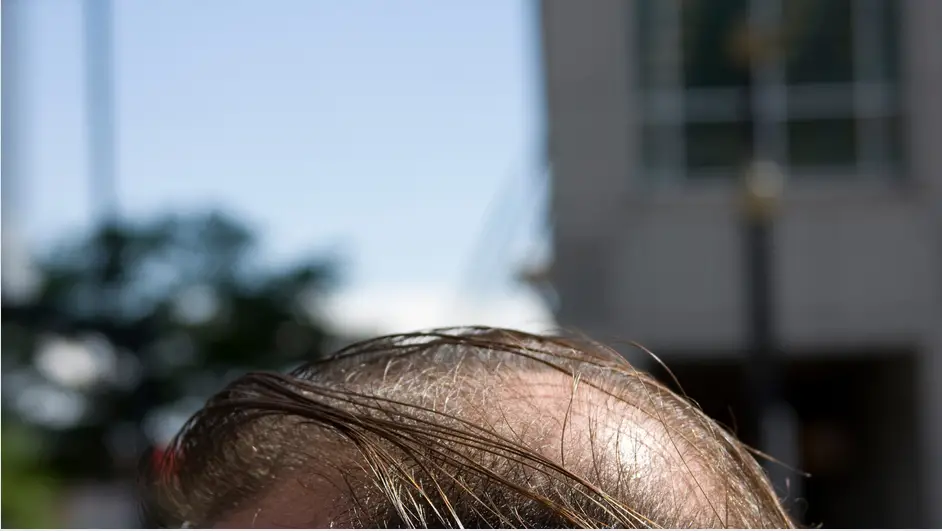
It’s important to note that hairstyles that pull tightly can lead to further hair loss, including receding hairlines. So if you’re experiencing signs of thinning or balding at your temples or forehead, it may be best to avoid tight ponytails or braids and opt for looser styles like a messy bun or loose waves instead. Remember, embracing your natural look can also be empowering – so don’t feel like you always need to hide behind a certain hairstyle!
Shaggy Hairstyle
One of the top 10 hairstyles for a receding hairline is the shaggy hairstyle, which is a great option for both men and women. This hairstyle features longer layers that can help to create volume and movement in the hair, making it perfect for those with thinning or receding hairlines.
To achieve this look, ask your hairstylist to cut your hair into long layers and add texture throughout. You can then style your hair by using a texturizing spray or sea salt spray to create a messy, undone look that hides any areas of thinning or receding hair.
However, keep in mind that using too much product or applying it too close to the scalp can lead to further damage to the hair follicles and contribute to a receding hairline. So, be sure to use these products sparingly and avoid pulling on the hair while styling.
Quiff Hairstyle
The Quiff hairstyle is a popular choice among men with receding hairlines. This style involves longer hair on top that is combed upwards and back. The sides are kept short, and the hair gradually tapers down towards the nape of the neck. This style can be achieved with or without a fade on the sides.
One advantage of the Quiff hairstyle is that it helps to add height and volume to the hair, which can help to balance out a receding hairline. It’s also low maintenance and easy to style, making it an excellent option for those who are short on time in their daily grooming routine. However, it’s important to note that this style may not work for everyone depending on their particular pattern of thinning or balding.
Overall, if you have a receding hairline but still have some length at the top of your head, give the Quiff hairstyle a try! With proper styling techniques and products such as mousse or pomade, you can create an attractive look while effectively masking some of your signs of balding.
Caesar Cut
The Caesar Cut is a short, textured hairstyle that is popular among men with receding hairlines. The style features short, choppy layers that are combed forward and cut at an angle. Here are some key points to keep in mind when styling a Caesar Cut:
1. Start by washing your hair with a gentle shampoo and conditioner to remove any buildup from styling products.
2. Towel-dry your hair until it’s damp but not dripping wet.
3. Apply a small amount of styling gel or pomade to your hands and rub it between your palms.
4. Use your fingers to tousle your hair, creating texture and volume.
5. Comb the front section of your hair forward and down, creating a “fringe” that falls just above your eyebrows.
6. Use scissors or clippers to trim any stray hairs around the edges of the style, including the sideburns and the back of the neck.
7. Finish with a spritz of hairspray or matte-finish pomade to hold the style in place without making it look greasy or stiff.
Remember: The Caesar Cut works best on men with straight or wavy hair that is thick enough to hold its shape without looking too flat or limp. If you have curly or fine hair, you may need to experiment with different products and techniques to achieve the desired look. Additionally, avoid hairstyles that pull tightly on the scalp, as they can lead to further damage and thinning of the hairline over time.
French Crop
The French Crop hairstyle has become a popular choice for men with a receding hairline. This style features short sides and back, while the top is kept longer and textured for an edgy look. The French Crop can be done in various lengths and textures, making it versatile enough to suit different face shapes and personal styles.
One of the advantages of the French Crop is that it draws attention away from thinning areas on the forehead by creating a fuller appearance at the crown of your head. However, if you’re experiencing significant hair loss, this style may not work as well. It’s best to consult with a hairstylist who specializes in dealing with receding hairlines before committing to this cut. Additionally, styling products like pomade or wax can help add volume and texture to your hair without weighing it down or damaging what remains of your strands.
Textured Crop
The textured crop hairstyle is a popular choice for those with receding hairlines, as it can help to create the illusion of thicker hair and draw less attention to the hairline. Here are some key points about this hairstyle:
1. The textured Crop typically involves cutting the hair shorter on the sides and leaving it longer and more textured on top.
2. This style works particularly well for men with thinning hair, as it can help to create volume and add dimension to the hair.
3. For women with receding hairlines, a similar style may involve adding layers to their haircut to create texture and volume.
4. To maintain this style, regular trims every four to six weeks may be necessary.
5. It’s important to avoid using heavy products or styling tools that can damage the hair and cause further hair loss. Opt for lighter products designed for thinning or receding hair instead.
Remember, while hairstyles can help to boost confidence and draw less attention to a receding hairline, addressing the underlying causes of hair loss is essential for long-term prevention and treatment. Consider speaking with a healthcare professional or specialist regarding effective treatment options for your individual needs.
Treatment And Prevention Of Receding Hairline
There are several treatment options for a receding hairline, including lifestyle changes like stress reduction and a healthy diet, topical treatments like Minoxidil and Finasteride, hair restoration surgery, and natural remedies such as supplements and scalp massage.
Lifestyle Changes Such As Stress Reduction And a Healthy Diet
Making certain lifestyle changes can help manage the symptoms of receding hairline. Here are some tips to reduce stress and maintain a healthy diet:
1. Regular exercise: Physical activity is essential for improving blood circulation, which helps stimulate hair growth.
2. Meditation and relaxation techniques: These practices can help reduce stress levels, which is important since excessive stress is linked to hair loss.
3. Avoid smoking and alcohol consumption: Both smoking and drinking alcohol may contribute to hair loss by reducing blood flow to the scalp.
4. Eat a balanced diet: Eating a variety of nutrient-rich foods such as fruits, vegetables, whole grains, lean proteins, and healthy fats can support hair health.
5. Stay hydrated: Drinking plenty of water throughout the day can help keep your scalp hydrated and improve overall health.
6. Reduce caffeine intake: Consuming too much caffeine may increase cortisol (the stress hormone) levels in the body, which could contribute to hair loss.
7. Get enough sleep: Getting sufficient rest is critical for overall health as well as promoting optimal hair growth.
By incorporating these lifestyle changes into your routine, you may be able to prevent or potentially reverse some of the symptoms associated with receding hairline.
Topical Treatments Such As Minoxidil And Finasteride
Topical treatments such as Minoxidil and finasteride can be effective in treating and preventing receding hairline signs in both men and women. Here are some important facts to know about these treatments:
1. Minoxidil: This topical treatment is applied directly to the scalp and works by increasing blood flow and oxygen to the hair follicles, which can stimulate hair growth. It has been approved by the FDA for use in treating male pattern baldness, but it can also be effective in treating receding hairlines in women.
2. Finasteride: This prescription pill works by blocking the production of DHT, a hormone that shrinks hair follicles and leads to hair loss. It has also been approved by the FDA for use in treating male pattern baldness.
3. Both Minoxidil and finasteride should be used consistently for several months before results are seen.
4. Side effects of these treatments may include scalp irritation, itching, or dryness.
5. These treatments can be expensive, as they typically require ongoing use over an extended period of time.
6. It is important to speak with a doctor or dermatologist before starting any new topical or oral treatments for receding hairline signs or other forms of hair loss.
Hair Restoration Surgery
Hair restoration surgery is a popular long-term solution for those suffering from receding hairlines. It involves transplanting healthy hair follicles to areas where the hairline has receded, creating a natural-looking hairline that blends in with your existing hair. However, it is important to note that this procedure can be costly and may not be suitable for everyone.
Before considering surgery, it’s recommended to stabilize the progression of balding with medical treatment and restore lost density. This allows for better results during the transplant process and reduces the need for multiple surgeries. While restoration surgery can help restore confidence and self-esteem in individuals affected by receding hairlines, it’s advisable to consult with a reputable specialist to determine if you are an ideal candidate for this type of treatment.
Natural Remedies Such As Supplements And Scalp Massage
If you’re looking for natural ways to combat a receding hairline, there are some supplements and techniques you can try. Here are a few:
1. Biotin: Taking biotin supplements may help promote healthy hair growth, according to research studies.
2. Saw Palmetto: This herb is believed to work by preventing testosterone from converting into dihydrotestosterone (DHT), which is known to cause hair loss.
3. Melatonin: As the hormone that regulates sleep, melatonin can help regulate hair growth, too, evidence suggests.
4. Scalp Massage: Massaging your scalp for just a few minutes each day can increase blood flow and circulation, thereby promoting hair growth.
5. Aloe Vera: Applying pure aloe vera gel to the scalp may help soothe and moisturize the skin while also encouraging new hair growth.
Remember that it’s always important to consult with a healthcare professional before adding any supplements or treatments to your routine.
How To Care For Receding Hairline
Proper hair care is essential for those experiencing a receding hairline; avoiding harsh chemicals, using gentle products, and taking care of your scalp are just a few ways to help maintain healthy hair. Keep reading to learn more about how you can care for your receding hairline and prevent further damage.
Avoiding Harsh Chemicals
One way to care for a receding hairline is by avoiding harsh chemicals. Chemicals in hair products can damage the hair cuticle and contribute to hair loss, making it important to read product labels carefully before use. Shampoos with sulfates, for example, can strip away natural oils from the scalp and lead to dryness or irritation that worsens hair loss.
Chemicals found in dyes and perm solutions can also be harmful to the hair follicles, so colouring or perming should be done sparingly, if at all. Opting for more gentle, natural alternatives like henna dye or highlights could help reduce further damage to fragile strands while promoting healthier growth in areas of recession.
Using Gentle Hair Care Products
Caring for a receding hairline starts with using gentle and non-harsh hair care products. Avoid shampoos or conditioners that contain sulfates, silicones, and parabens, as they can strip the natural oils from your scalp and damage the hair follicles. Instead, opt for mild and organic products that are free of these harsh chemicals.
In addition to being gentle on your scalp, you may also want to consider using specialized shampoos or treatments designed for thinning hair. These products contain active ingredients such as saw palmetto and pyrithione zinc, which can help fortify the strands of your hair while promoting growth.
Finally, minimize heat styling tools like curling irons, flat irons, and blow dryers since high temperatures can cause breakage in already weakened hair that occurs due to receding hairline. Letting your locks air dry or using a diffuser on low speed is recommended instead of aggressive heat styling.
Taking Care Of Your Scalp
To maintain healthy hair growth, it’s important to take care of your scalp. Keep your scalp hydrated by using gentle shampoos and conditioners that are free from harsh chemicals. Avoid over-washing or scrubbing, as this can strip the natural oils from your scalp, which can lead to dryness and irritation.
If you have a receding hairline, massaging your scalp with essential oils such as lavender or rosemary oil may help stimulate blood flow to the hair follicles and promote healthier hair growth. Additionally, regularly exfoliating your scalp can also help remove dead skin cells and unclog blocked pores. However, be mindful not to over-exfoliate, as too much friction could damage delicate hairs around the hairline.
Ways To Boost Confidence With Receding Hairline
Boosting your confidence with a receding hairline is possible – from embracing your natural look to focusing on self-care. Read on for tips that can help you feel more confident and comfortable in your own skin.
Embracing Your Natural Look
One of the best ways to boost confidence with a receding hairline is by embracing your natural look. It’s understandable that losing hair can be daunting and make some individuals feel self-conscious. However, many people find baldness attractive, and it is essential to recognize that beauty comes in all forms. Embracing your natural look may require some adjustments to your hairstyle or wardrobe, but it’s also an opportunity to experiment with new styles and accessories, such as hats or headbands.
By choosing not to hide behind wigs or fake hairpieces, you are showing that there’s nothing wrong with being bald. You may even inspire others who are struggling with their appearance due to alopecia or other conditions. Furthermore, accepting yourself the way you are will help improve self-esteem and reduce stress levels associated with trying to cover up hair loss using unnatural methods.
Another way to embrace your natural look is by maintaining a good posture. Walking tall and proud shows that you’re confident in who you are regardless of whether or not you have hair on top of your head. Remembering this simple tip can go a long way in helping one navigate society confidently without feeling like they need something more for acceptance when dealing with receding hairline signs in men and women alike.
Accessorizing With Hats And Headbands
If you’re experiencing a receding hairline, it’s natural to want to cover it up. Hats, scarves, and headbands can be excellent options to boost your confidence and take attention away from thinning hair. You can choose from different styles of hats, such as fedoras or beanies, that fit comfortably and securely on the head without causing friction on the scalp. Another option is wearing a stylish scarf or wrap around your head for added protection against cold weather or sun damage.
Headbands are another way to accessorize while also helping with the practicality of keeping hair off of your face. However, when choosing a headband, be sure not to pick one that’s too tight, as it could lead to Traction Alopecia—a condition that can cause permanent baldness if not treated in time! Opt for adjustable elastic bands instead or ones made using soft materials such as cotton, which do not pull on hair strands. It’s always best practice to switch up the placement of the band often so the pressure isn’t constantly applied at one spot leading also minimizing risks like headaches.
Ultimately, remember that accessories should make you feel good about yourself and enhance your personal style–not detract from your confidence because they are uncomfortable or damaging. A variety of fashionable options exist; experiment until finding what feels right!
Maintaining Good Posture
Maintaining good posture can help individuals with receding hairlines boost their confidence and appearance. Slouching can make the hairline look even more pronounced while standing tall, and keeping the shoulders back can create a better overall silhouette. It’s also important to avoid tugging on or excessively styling hair, which can further damage thinning follicles.
Aside from improving appearance, proper posture has numerous other benefits for overall health as well. It helps reduce strain on the spine and joints, improve breathing and circulation, and increase energy levels. By making small changes to daily habits like sitting up straighter at work or adjusting sleeping positions at night, individuals with receding hairlines can both feel better physically and appear more confident in their natural look.
Focusing On Self-Care
Dealing with hair loss can take a toll on one’s mental health and confidence. That is why focusing on self-care should be a priority for those experiencing receding hairline signs in men and females. Taking care of oneself physically and mentally can help boost confidence levels, which, in turn, positively affects self-esteem.
Self-care practices include getting enough sleep, exercising regularly, eating healthy food, meditating or practising mindfulness to reduce stress levels. It also includes doing things that make you happy and staying connected with friends and family for emotional support. Focusing on yourself and making time for activities that bring joy will not only improve your quality of life but also helps to cope better with the frustration of losing hair due to receding hairline signs.
Research shows that people view balding as negative because society perceives it as being less attractive than having a full head of hair. However, embracing your natural look is another form of self-care strategy when dealing with receding hairline signs in men or female individuals. Many celebrities have gone bald gracefully without any regret; they even consider it part of their personality! So instead of feeling ashamed about it or covering up constantly with hats or wigs – adopt a positive mindset towards baldness – Be proud and embrace it!
FAQs: Signs of Receding Hairline
– Can a receding hairline be reversed?
There is currently no guaranteed way to completely reverse a receding hairline. However, there are treatments available that can slow down or stop hair loss and even promote new hair growth.
– Is it normal to experience a receding hairline at a young age?
It is not uncommon for men to experience a receding hairline in their early 20s or even earlier. This can be due to genetic factors, hormonal imbalances, or lifestyle habits such as smoking and poor diet.
– Can women also experience a receding hairline?
Yes, women can also experience a receding hairline, although it is less common than in men. Female pattern baldness usually results in thinning of the hair all over the head rather than just at the hairline.
– Are there any natural remedies for treating a receding hairline?
While natural remedies such as essential oils and scalp massages may help with stimulating new hair growth, they are not proven to treat a receding hairline on their own. It is important to consult with a healthcare professional for proper treatment.
– Does wearing hats cause a receding hairline?
Wearing hats does not directly cause a receding hairline, but tight-fitting hats may contribute to Traction Alopecia, which is another type of reversible hair loss caused by pulling force on the follicles over time.
– Is stress related to receding hairlines?
Stress can have an impact on overall health, including the health of your scalp and follicles. Chronic stress may lead to conditions such as Telogen Effluvium (temporary shedding), but it’s less likely that stress alone will directly cause male pattern baldness or female pattern baldness.
– Is there any connection between smoking and receding hairlines?
Smoking has been linked to various health problems, including heart disease and lung cancer. There is also some evidence that smoking may contribute to hair loss or alopecia.
– Can certain medications cause a receding hairline?
Some medications, such as chemotherapy drugs and steroids, can cause temporary hair loss. It is important to consult with a healthcare professional if you are experiencing sudden or severe hair loss while taking any medication.
– How can I prevent my receding hairline from getting worse?
There are several ways to prevent a receding hairline from getting worse, including maintaining a healthy lifestyle with proper nutrition and exercise, avoiding harsh chemicals and treatments on your hair, and
Conclusion
In conclusion, a receding hairline can be a daunting experience for both men and women. However, it is important to remember that it is not uncommon, and there are several treatment options available.
By identifying the signs of a receding hairline early on, seeking professional help when needed, and taking preventative measures such as adopting a healthy lifestyle and avoiding tight hairstyles or harsh chemicals, you can manage this condition effectively. Remember to embrace your natural look and focus on self-care to boost your confidence. Don’t let hair loss define you – with the right approach, you can maintain the great style and good health no matter what your hairline looks like!
Sources of information
- https://www.healthline.com/health/receding-hairline
- https://www.medicalnewstoday.com/articles/320537
- https://www.mayoclinic.org/diseases-conditions/hair-loss/symptoms-causes/syc-20372926
- https://www.verywellhealth.com/receding-hairline-overview-4684593
- AI Powered Bald Filter Online 2024: See Yourself with No Hair! - January 19, 2024
- Harklinikken Bad Reviews 2024: Analyzing Negative Feedbacks - January 18, 2024
- How to Get the Alex Eubank Hair | Step-By-Step Tutorial 2024 - January 18, 2024

